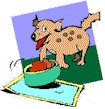|
|
Diet plays an important role in keeping your pet's
diabetes well regulated. Because insulin requirements change depending on the amount and
type of food eaten, a consistent, high-quality diet that the pet will reliably eat is
important. The healthier and more consistent the diet, the easier it will be to control
the blood glucose. View sample bg charts showing the
relationship between food and bg. on the amount and
type of food eaten, a consistent, high-quality diet that the pet will reliably eat is
important. The healthier and more consistent the diet, the easier it will be to control
the blood glucose. View sample bg charts showing the
relationship between food and bg.
Type of diet
The ideal composition of the diet for
diabetic pets has not been determined, and research continues in this area. However,
many vets recommend a special diet that has a higher fiber content than commercially
available foods. These special diets usually contain a greater amount of soluble fiber.
Research in humans and in some animal studies shows that soluble fiber slows the
absorption of glucose from the digestive system. This helps prevent a rapid rise in the
blood glucose after a meal. You will see this referred to as postprandial (after eating)
blood glucose. Several special diets are available by prescription from your veterinarian.
Hills w/d is a commonly used prescription diet. Purina, Eukanuba, and other pet food
manufacturers also make prescription diets.
Another school of thought, particularly for diabetic cats, is to feed a
higher protein diet. Purina has developed a prescription Diabetes
Management Formula. Many diabet cat owners have reported that their
cat requires less insulin when fed this diet compared to other diets.
Purina provides a feeding plan to your veterinarian to help switch from
normal or higher fiber diets to the higher protein diet while at the same
time preventing insulin overdose.
Some pets refuse to eat prescription foods, or the prescription foods may not be a good
choice for your pet because of other health reasons. Many diabetic pets eat high-quality
commercially available foods and their blood glucose is regulated very well. The
"best" prescription diet won't do your pet any good if he refuses to eat it.
However, soft or semi-moist pet foods should be avoided. They often contain a lot of
sugar and their moist consistency causes a dramatic rise in the blood glucose after a meal.
There are special circumstances that require even more specialized diets. If your diabetic
pet is obese, gradual weight loss is very important. Weight loss can improve
the body's sensitivity to insulin and may help to reduce your pet's need for insulin. Some cats with diabetes
no longer require insulin after their weight is returned to a healthy level. Rapid weight
loss should be avoided. If your diabetic pet is underweight, a reduced calorie diet is not
recommended because of the possibility of the animal continuing to lose weight and
becoming ketoacidotic. Your vet is the best person to decide which special diet is
appropriate for your pet.
Comparison of commercial and prescription foods.
Different foods can be significantly different in their
ingredients and composition. Here are charts comparing some commonly used foods.
Some people use baby food to supplement their pet's diet, or to encourage eating, so it is
also included here.
Home
Cooking 
Because of potential problems with variability in the composition of the food and
unbalanced nutrition, home-cooking is not usually recommended for diabetic pets. But some
owners have pets that will not eat commercial pet foods, some pets have severe health
problems that can only be managed using a home-cooked diet, or some owners feel that
home-cooked food is healthier for their pet. If you are home-cooking for your pet, keeping
the food healthy, well balanced, and consistent from meal to meal is very important. There
are several books available that discuss canine and feline nutrition and many have recipes
for home-cooked meals. Your veterinarian may also be able to help with the diet, or may be
able to refer you to a veterinarian who is familiar with the special nutritional needs of
a diabetic pet.
Many owners home cook for their diabetic pet, or use a combination of home cooking and
commercial foods.
Here are recipes for home cooking.
What do you feed your pet?
Participate in our quick web survey.
Timing of
meals
The timing of your pet's meals should be
adjusted to give the best control over the blood glucose. In general, food should be given
before the insulin activity peaks. This way, the sugar from the food is available during
the time when the insulin is active. This helps keep the blood glucose more stable.
Some pets are put on a very strict feeding schedule while others are allowed to free-feed. The
type of feeding regimen you use must be designed specifically for your pet. Here are
some things to consider.
- A pet who is "gluttonous" - eats as much as possible
all the time - will probably have to be put on a feeding schedule.
- A pet that
"nibbles" throughout the day may do better if allowed to free-feed.
- It may be very difficult and stressful
on the pet to try to convert a nibbler to a scheduled feeding and
vice-versa.
- Scheduled
feedings are more important when the insulin has a strong peak. Food given after the peak
will dramatically increase the blood glucose because there is little insulin around to
counteract the sugar that is being absorbed into the body from the food.
- Strict feeding
schedules are less important when the insulin has a very gradual onset and a gradual
curve. The insulin is present in a fairly constant amount throughout the day, so the sugar
from food will be absorbed and utilized.
Treats

Treats can be part of your
diabetic pet's daily routine. Many pets are accustomed
to receiving treats during the day, and eliminating treats from the daily routine may make
your pet unhappy and feel like he is being punished. Healthy treats are available and many owners use treats as part of the
daily diabetes management routine. Giving a small treat when you give the insulin
injection can be a great reward for your pet. Some owners give a treat when the blood
glucose is at its lowest.
Choosing a healthy
and appropriate treat
Choosing a treat
requires reading the labels and deciding what purpose you want the treat
to serve.
A general purpose
treat:
- Should have no obvious sources of
sugar. Look on the ingredient list for corn
syrup, malt syrup, molasses, cane molasses, cane sugar, fructose, dextrose,
or maltose.
- Look for complex
carbohydrates (whole grains) and meat products as main
ingredients. There are several dehydrated or freeze-dried meat
products available for both cats and dogs, and many treats that have
no sugar added.
A treat can be used
to raise your pet's blood glucose.
- When the bg is a little
lower than you would like, but not so low that it requires treating
with corn syrup (Karo), regular food or a treat that contains a
moderate amount of sugar may be what your pet needs. In this
case, the treats that contain sugar might be appropriate.
Here's
a chart of pet treats categorized by sugar content.
Other treat
options:
-
Fresh low-sugar vegetables like broccoli,
cauliflower, green or red sweet peppers, carrots, turnips
-
Tofu
-
A few pieces of
healthy pet food that is not part of your pet's usual
diet. Our cat loves a "treat" of the non-prescription
food that non-diabetic cats eat.
- Take your pet's usual dry food, crush it, moisten it with a bit of low-fat,
low-salt chicken broth, then bake it in a warm oven until it dries
out. Sometimes just a different shape or texture is enough for your
pet to think he's getting a special treat.
- Bake prescription canned
food into a treat. One owner discovered her dogs love baked canned W/D.
Here's how to make the treats. Put the can in the refrigerator so
the food gets more firm. After a few hours, take the can out and
open both ends. Use one end piece to push the cylinder of food out
of the can. Slice the food into very thin slabs. Bake the slices on a cookie sheet at 350
degrees for about 10-15 minutes, then turn the slices over and bake the
other side for about 5-10 minutes. The baking time will depend on how
thick the slices are, but the slices will get a dried crust on each
side. If you cut them too thick, the center will still be soft. A soft
center is not a problem for the dogs, it just gets your fingers messy if
you try to split them into pieces. After baking, let the treats cool on
a cooling rack or paper towel. Store the baked treats in a sealed
container in the refrigerator. Warning - the kitchen doesn't smell very
good during the baking process. If you bake batches of several cans at a
time, it means less stinky cooking days.
Other
treat tips
-
Treats should be given in
moderation.
-
Larger
treats can be broken into smaller pieces.
-
Treats can
be part of play time ... treat-hide-and-seek or treat-fetch.
-
There are
several toys that hold treats and make the pet do a little thinking to
get the treat out. This would help slow down those
treat-gulpers.
-
If your pet
knows not to nibble (or chomp) your fingers, holding the treat and
making him work a bit for the treat often makes them chew instead of
gulping it down.
-
A tiny treat
and a lot of love and attention will often satisfy even the most
persistent treat-lover.
Tips for
picky eaters or when your pet refuses to eat
Changing diets
Some newly diagnosed (or
not so newly diagnosed) pets are reluctant to eat a new food. When our cat Barney was diagnosed with diabetes we tried to
switch him to a prescription dry food (kibble). He would eat the canned
prescription food, but not the kibble. We already had him on a kibble that was
acceptable for a diabetic, so we allowed him to continue eating it until he
was feeling better and more accustomed to the new diabetes routine.
When we began the change, each day we exchanged a few of his "regular" kibbles
with the prescription kibble and over the course of a few weeks, we had him switched over to
100 percent prescription kibble. Unless your pet is eating an
unhealthy diet or your vet recommends an immediate diet change, this gradual
method of changing the diet is usually accepted by most pets and is easy on
their system. new food. When our cat Barney was diagnosed with diabetes we tried to
switch him to a prescription dry food (kibble). He would eat the canned
prescription food, but not the kibble. We already had him on a kibble that was
acceptable for a diabetic, so we allowed him to continue eating it until he
was feeling better and more accustomed to the new diabetes routine.
When we began the change, each day we exchanged a few of his "regular" kibbles
with the prescription kibble and over the course of a few weeks, we had him switched over to
100 percent prescription kibble. Unless your pet is eating an
unhealthy diet or your vet recommends an immediate diet change, this gradual
method of changing the diet is usually accepted by most pets and is easy on
their system.
Refusing Meals
There will probably be times when your pet refuses to eat. With diabetes, eating
consistently is very important. It's even more stressful for you and potentially
life-threatening for the pet if you have already given the insulin injection and then
your pet refuses to eat. There are a few tricks you can try to entice your pet to eat. But
check with the vet to be sure anything you try is ok.
Toppings
The idea is to put a little bit of your pet's favorite food or a little bit of
a healthy treat in with the usual food to entice your pet to eat. The
trick is to incorporate the favorite food into the usual food so the
pet can't pick out the yummy food and leave the rest.
Toppings that work well for cats are:
- a small amount (less than a tablespoon) of
a favorite canned cat food. Choose a healthy food.
- a bit of water-packed tuna
- cooked chicken shredded into small
bits
- scrambled eggs
-
Something we found that did not work was to try to wet the kibble
with water or juice from a can of tuna. It just made a mushy
mess that Barney refused to eat.
Dog owners have reported a few tricks of their own:
- A little "healthy"
(low-fat, low-salt) chicken broth added to the food is a real treat to some
dogs, and unlike cats, they don't seem to mind their food getting a bit
mushy
- Campbell's
chicken noodle soup
- A bit of whole wheat bread
or crumbled crackers
Feeding a different
food
If your pet has already had it's insulin shot or absolutely must eat a meal
for some other reason, it may be acceptable to feed a reasonably healthy and
complete food that the pet really enjoys, even if it is not the pet's usual
food. Eating something is usually better than eating nothing.
This is probably ok for a meal or two, but if the lack of appetite or abnormal
eating habits continue, be sure to check with your vet and get
advice. As an example of not eating, Barney was quite ill for about 7
days. During this time he was adjusting to a new medication and he
either did not eat or vomited his usual food. We found that he would
eat (and not vomit) scrambled eggs, so that was a large portion of his diet
for several days. I would even take a few of his kibbles, crush them, and
mix it in with the eggs. Since he was still getting insulin for his
diabetes, eating scrambled eggs was better than eating nothing, and we had
the vet's approval to let him eat whatever he would keep down.
References
Canine and Feline Nutrition: A resource
for companion animal professionals. Linda P. Case, Daniel P. Carey, Diane A. Hirakawa.
1994.
Pocket Companion to the Fourth Edition of Textbook of Veterinary Internal Medicine.
Stephen J. Ettinger, D.V.M, Editor. 1995. W.B. Saunders Co.
 |
The 5 Minute
Veterinary Consult: Canine and Feline Larry P. Tilly, Francis W.K. Smith, Jr. 1997.
Williams & Wilkins. Hardcover 1997. General veterinary reference book with
clear, concise summaries. Might be too technical for most people. |
 |
Dr.
Pitcairn's Complete Guide to Natural Health for Dogs and Cats. Richard H. Pitcairn,
Susan Hubble Pitcairn. 1995. An A-to-Z encyclopedia of common pet ailments and their
treatments also features tips on a do-it-yourself pet checkup, recipes for healthier food,
sources of herbal and homeopathic supplies, and more. Easy to understand. Dr.
Pitcairn suggests you use the ideas that suit your beliefs. |
 




Updated January 2005
Copyright. All rights reserved.
This site is for information purposes only. Please consult
your veterinarian. |
 Diet
Diet Diet
Diet on the amount and
type of food eaten, a consistent, high-quality diet that the pet will reliably eat is
important. The healthier and more consistent the diet, the easier it will be to control
the blood glucose. View sample bg charts showing the
relationship between food and bg.
on the amount and
type of food eaten, a consistent, high-quality diet that the pet will reliably eat is
important. The healthier and more consistent the diet, the easier it will be to control
the blood glucose. View sample bg charts showing the
relationship between food and bg.